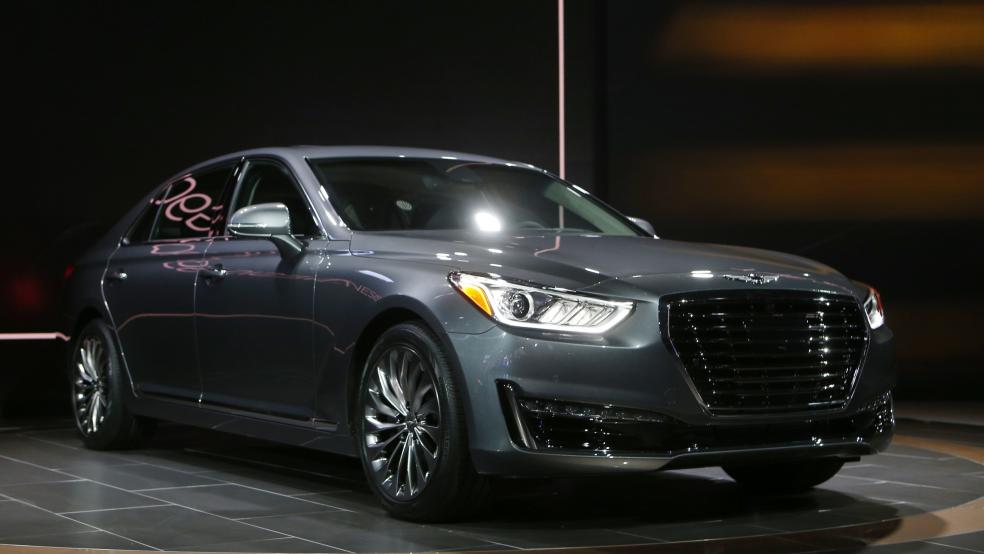
Patrick Primm, a partner at Cascade Audi in Cuyahoga Falls, Ohio, had his top sales total ever last year. Primm sold 288 cars, up 8.7 percent over the previous year.
Primm’s fruitful 2015 was part of a milestone year for the industry overall, which sold a record 17.39 million vehicles, according to WardsAuto. Audi also had its best year, with record-setting sales of 202,202 vehicles, up 11 percent from 2014.
Though the skyrocketing sales of SUVs, which are overtaking sedans, fueled that larger success, there’s another segment that is similarly faring well: luxury vehicles.
Related: The 10 Best Cars of 2016
Since 2009, the height of the recession, luxury vehicles have increased their share of the market from 11.5 percent to 12.9 percent in 2015, according to WardsAuto. A rebounding economy is a big factor, along with growth in international markets like China.
Luxury vehicles are also getting a boost from the increasing availability of leases and low interest rates, which make the cars more affordable and appealing (since they’re expensive to repair, customers don’t want to own high-end cars when they’re out of warranty), according to Jon Linkov, deputy auto editor for Consumer Reports. An Audi Q3 with all-wheel drive has a base price of around $34,000, just $4,000 more than a loaded Honda Accord EX-L. A 39-month lease (what Audi often offers) is about $510/month with $5,000 down.
Leasing is “a new way of reaching into a new market where you can charge a premium,” said Linkov. BMW, which was just named the No. 1 luxury car maker, said 75 percent of customers lease the BMW 7 series. That figure is 65 percent for Mercedes vehicles.
Related: Americans Now Owe $1 Trillion in Car Loans
At the North American International Auto Show in Detroit, which opens to the public on Jan. 16, there’s expected to be buzz around a plethora of new luxury offerings intended to further whet the public’s appetite for upscale cars. These include the Volvo S90; the refreshed Infiniti Q50; Hyundai’s Genesis G90, the first offering in the Genesis nameplate; the Buick Envision; the Lincoln Continental; the Audi Q7; the Mercedes E-Class and SLC roadster; and a Lexus concept LC500.
Luxury cars have grown at about the same pace as the overall market, “but unlike a lot of other segments, they have been able to maintain their pricing and appeal” in a way other segments have not managed to do, said Steven Szakaly, chief economist for the National Automobile Dealers Association.
Though the car segment hasn’t been as hot as SUVs and light trucks, luxury sedans do better “because people are willing to pay a premium for an emblem on the front and back of the car,” Szakaly said. The auto show, he said, will provide more luxury products in both the light truck segment as well as refreshers and redesigns in the car segment, “which is always good for the market, since new products drive sales.”
One of the splashiest entrants into the luxury space comes from Hyundai, which is establishing a new Genesis nameplate with its G90 that will be sold in a separate showroom from the rest of Hyundai products, similar to how Lexus functions for Toyota. Linkov expects the vehicle will emphasize value, providing a variety of creature comforts, power and styling for less than competing luxury vehicles, adding a new level of competition.
Made in China, Sold in the U.S.
Another big factor driving activity in the luxury sector is the international market, something Buick is taking advantage of, bringing to the U.S. its Envision, manufactured in China. Buick sold 150,000 in 2015, the first year they were sold in China. “If you’re going to have a successful car company, you have to have a solid offering in China,” said Karl Brauer, senior analyst with Kelley Blue Book.
Related: The Incredible Disappearing American-Made Car
Brauer said that the Chinese appreciate luxury vehicles because of the status they convey; the same goes for India, he said, where “getting a luxury car proves you’ve made it.” Jessica Caldwell, director of industry analysis for Edmunds.com, says that while owning a Buick doesn’t ooze status in the U.S., that’s not the case in China. She says many years ago, the only people who had cars in China were government officials, most of whom drove large Buicks, so the Chinese perceive them as a symbol of wealth and power. Because Buick has so heavily relied on sedans, a category which isn’t selling as well domestically, it is among the luxury makers with the smallest share of the U.S. market, 1.9 percent. “The SUV and truck side is where all the growth is,” said Linkov.
The Envision is the first new Buick vehicle launch since the Encore was introduced three years ago. Molly Peck, Buick’s marketing director, said the Envision — sized between the Encore and Enclave — will nicely round out its portfolio in the hot compact crossover segment; 58 percent of Buick’s sales in 2015 were crossovers. Its selling point, she said, is that it includes many comfort and safety features common in luxury vehicles, but at a more affordable price. “Five years ago, no one thought of Buick as a crossover brand, so adding another crossover is a really big deal for us. That’s where consumer preferences are headed as well,” she said.
Brauer says the “goldilocks just-right” size is key, and that the vehicle could be “huge” for Buick in reviving brand sales in the U.S. He expects it also is the start of another trend: “We will see more cars sold in the U.S. that are manufactured in China.” Caldwell says everyone is watching to see whether the Chinese quality will be acceptable and whether Americans will embrace a luxury brand manufactured there.
It’s also unclear whether the luxury momentum will continue. “A lot of these international markets are starting to turn, if not go down,” especially the Chinese market, Szakaly said. But Primm, the Cuyahoga Falls salesman, remains optimistic and is showing his confidence through a $4 million investment in a new Audi showroom, due to open in April.
[“source-thefiscaltimes”]





